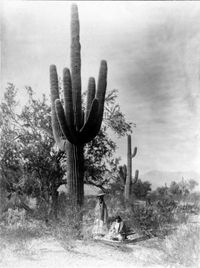The Peoples
O'odham / Pima and Papago / Sáíkiné
Related Documents
The group that called themselves simply the O'odham ("People") likely descended from some of the earliest agriculturalists in the borderlands: the Huhugam ("Vanishing People"), who built and later abandoned a number of imposing irrigated villages along some of the region's principal rivers sometime in the fifteenth century.

Among themselves, the O'odham distinguished between the Akimel O'odham ("River People"), Tohono O'odham ("Desert People"), and Hia-Ceḍ O'odham (the "Sand People"), based on each group's territory and mode of livelihood. The River People cultivated large irrigated farms of corn, pumpkins, beans, and other crops along the Gila River; the Sand People hunted and gathered in some of the most arid portions of the Sonoran Desert; and the Desert People, located between these two groups, both farmed and collected wild foodstuffs.
Although they spoke mutually intelligible dialects, O'odham political structure rarely extended beyond the level of the local village. In the years after 1680, many of these O'odham village sites were occupied by subsequent arrivals to the borderlands. As a result, a number of the region's most important place names are derived from the O'odham language: Tucson from Cuk ṣon ("Black Base"), Tubac from Cewagï ("Cloud"), and Arizona from 'Al ṣonag ("Place of the Small Spring"). Outsiders knew the O'odham by a variety of different names. To the Apache, the O'odham were the Sáíkiné ("Sand House People") or Ketl'ah izláhé ("Rope Under Their Feet People," for the sandals they wore). To the Spanish and, later, Mexicans and Americans, the Akimel O'odham were the Pima, while the Tohono O'odham were the Papago. That both of these terms may well have been mistranslations of other O'odham terms — pi ha'icu ("nothing") and Babawï oodham ("bean eater") — illustrates the frequent misunderstandings that occurred when attempting to communicate between groups in the borderlands.
The O'odham reckoned their history using "calendar sticks"-ribs from the saguaro cactus, marked with distinctive figures that helped their keepers to recall important events on a year-by-year basis. In keeping with the importance of water to life in Sonoran desert, the O'odham measured each year not from January to December but rather from one summer rainy period to the next.








